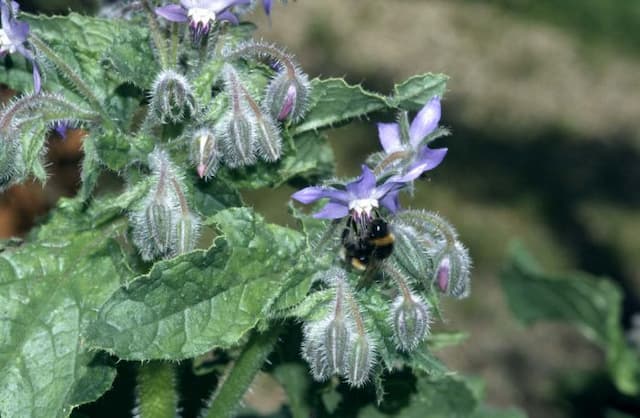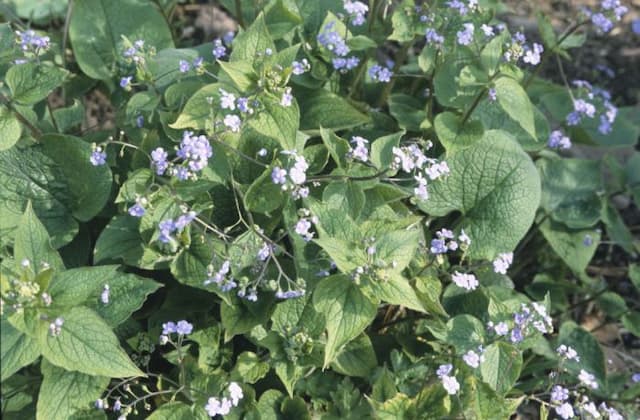Lacy phacelia Phacelia tanacetifolia

ABOUT
The plant Phacelia tanacetifolia, commonly known as lacy phacelia or blue tansy, is characterized by its fern-like foliage and striking purple-blue flowers. The leaves of the plant are deeply cut and resemble the leaves of the tansy plant, hence the species part of the name that suggests a similarity to tansy. These leaves are arranged in a rosette pattern at the base of the plant. The flowers of lacy phacelia are distinctive and eye-catching. They form dense, scorpion tail-like spikes that coil at the tip. Each flower is small and bell-shaped, boasting a vibrant purple-blue hue with stamens that protrude out, giving them a fuzzy appearance. The blooms are tightly clustered along the flower spikes and are known to attract pollinators such as bees and butterflies. The flowering spikes uncoil as the flowers mature, creating an elongated and somewhat spiraled effect. The overall appearance is both delicate and intricate, with the combination of the feathery leaves and the colorful, curled flower spikes lending a soft yet complex texture to the plant’s profile. Lacy phacelia can add a splash of cool color and attractive foliage to any garden setting.
About this plant
 Names
NamesFamily
Boraginaceae.
Synonyms
Lacy Phacelia, Blue Tansy, Purple Tansy, Fiddleneck, Scorpionweed, Tansy-leaf Phacelia.
Common names
Phacelia tanacetifolia Benth.
 Toxicity
ToxicityTo humans
Lacy phacelia is not generally considered to be toxic to humans. There is no widespread documentation of toxicity or poisoning in humans due to ingestion of lacy phacelia. As with any plant, individual allergies or sensitivities can occur, so it should be consumed with caution, especially if there is no prior experience with the plant.
To pets
Lacy phacelia is not typically known to be toxic to pets. As is the case with humans, there is a lack of reports indicating significant toxicity or harmful effects in pets due to ingestion of this plant. However, pet owners should always exercise caution and prevent pets from eating plants unless they are sure about their safety, as individual animals may have different sensitivities or allergic reactions.
 Characteristics
CharacteristicsLife cycle
Annuals
Foliage type
Deciduous
Color of leaves
Green
Flower color
Blue
Height
1-3 feet (0.3-0.9 meters)
Spread
1-2 feet (0.3-0.6 meters)
Plant type
Herb
Hardiness zones
3-9
Native area
North America
Benefits
 General Benefits
General Benefits- Attracts pollinators: Phacelia tanacetifolia is known to attract bees and other beneficial insects essential for pollination.
- Improves soil structure: Its roots can help break up compacted soil, allowing for better water infiltration and aeration.
- Cover crop: Often used as a green manure, it suppresses weeds and adds organic matter to the soil when incorporated before flowering.
- Erosion control: Its quick growth helps stabilize soil and prevent erosion, especially on slopes or in disturbed areas.
- Supports biodiversity: As a nectar source, it supports a diverse range of insects, thus enhancing biodiversity in the area.
- Ornamental use: With its attractive foliage and flowers, it is often planted for aesthetic purposes in gardens.
- Easy to grow: It is a hardy plant that can grow in various soil types and requires minimal care once established.
 Medical Properties
Medical PropertiesThis plant is not used for medical purposes.
 Air-purifying Qualities
Air-purifying QualitiesThis plant is not specifically known for air purifying qualities.
 Other Uses
Other Uses- Phacelia tanacetifolia, commonly known as lacy phacelia, has been used as a cover crop to protect and enhance soil health, due to its ability to suppress weeds, reduce soil erosion, and improve soil structure.
- Lacy phacelia is often planted by beekeepers as a honey plant because its flowers are a rich source of nectar, helping to produce high-quality honey.
- It can serve as a trap crop for pests such as aphids, luring them away from garden vegetables and preventing damage to more valuable plants.
- Lacy phacelia is used as a green manure when cut and incorporated into the soil, as it provides a substantial amount of biomass and nutrients for soil enrichment.
- The plant's quick growing nature and attractive blooms make it a suitable option for temporary ornamental displays in garden borders or wildflower meadows.
- Gardeners utilize lacy phacelia as part of companion planting strategies to attract beneficial insects such as predatory wasps and hoverflies that help control garden pests.
- It can be used to create a living mulch that suppresses weeds and helps to retain soil moisture during dry periods.
- Lacy phacelia seeds are sometimes included in “pollinator-friendly” seed mixes designed to support a variety of pollinators by providing diverse sources of pollen and nectar throughout the growing season.
- The dense foliage of lacy phacelia can be used as a smother crop to outcompete and suppress invasive plant species that might otherwise dominate a landscape.
- Some farmers use lacy phacelia as a border or buffer plant to enhance the appearance of their crop fields and provide a habitat for beneficial organisms at the field margins.
Interesting Facts
 Feng Shui
Feng ShuiThe plant Phacelia is not used in Feng Shui practice.
 Zodiac Sign Compitability
Zodiac Sign CompitabilityThe plant Phacelia is not used in astrology practice.
 Plant Symbolism
Plant Symbolism- Attraction of Beneficial Insects: Phacelia tanacetifolia, commonly known as "Lacy Phacelia," is celebrated for its capability to attract pollinators such as bees, which are essential for the reproduction of many plants and crops.
- Harmony with Nature: As a plant often used in organic farming systems and natural gardening, Lacy Phacelia represents a balance and collaboration with the natural world.
- Fertility and Abundance: Given its role in supporting the ecosystem by attracting pollinators, Lacy Phacelia is also seen as a symbol of fertility and abundance, signifying the continuity of growth and life.
- Healing and Restoration: Lacy Phacelia is used in agriculture to improve soil health and as a cover crop, which symbolizes healing and restoring of land that has been degraded or overused.
 Water
WaterLacy Phacelia should be watered deeply once every week to ten days, depending on the weather and soil conditions. It's crucial to ensure that the soil is moist but not waterlogged. During hotter, drier periods, water the plant more frequently to maintain consistent moisture. When watering, aim for about one to one and a half gallons per square yard every watering session. It's best to water early in the morning to reduce evaporation and allow the foliage to dry out during the day, reducing the risk of disease.
 Light
LightLacy Phacelia thrives best in full sunlight but can tolerate partial shade. The ideal spot for growing Lacy Phacelia would be an area that receives at least six to eight hours of direct sunlight each day. If planted in an area with less light, the plant may not bloom as vigorously and could become leggy as it reaches for light.
 Temperature
TemperatureLacy Phacelia prefers moderate temperatures and is hardy in USDA zones 3 to 10. It can withstand a minimum temperature of around 20°F but grows best when daytime temperatures are between 60°F and 75°F. The plant can tolerate some frost, but extreme heat or cold may reduce its vigor and blooming capability.
 Pruning
PruningPruning Lacy Phacelia is generally not necessary except to remove spent flowers if you wish to prevent self-seeding. Deadheading promotes additional blooming and prevents the plant from becoming too weedy, as it reseeds easily. The best time for pruning or deadheading is after the first bloom period, which usually occurs in late spring or early summer.
 Cleaning
CleaningNot needed
 Soil
SoilLacy Phacelia thrives in well-draining, loamy soil with a pH range of 6.0 to 7.0. The best soil mix for this plant is a blend of two parts garden soil, one part sand, and one part compost to ensure proper drainage and fertility.
 Repotting
RepottingLacy Phacelia is commonly grown as an annual and doesn't typically require repotting. It's sown directly where it is to grow and does not need to be moved once established.
 Humidity & Misting
Humidity & MistingLacy Phacelia is adaptable to a wide range of humidity conditions and does not require specific humidity levels, making it versatile for various growing environments.
 Suitable locations
Suitable locationsIndoor
Ensure bright light and good air circulation.
Outdoor
Plant in full sun, space 6-12 inches apart.
Hardiness zone
3-10 USDA.
 Life cycle
Life cyclePhacelia tanacetifolia, commonly known as lacy phacelia, begins its life as a seed that germinates in cool, moist soil, usually in the fall or early spring. The seedling emerges, developing a rosette of deeply lobed leaves before sending up a flowering stalk. The plant then produces distinctive purple or blue flowers arranged in coiled spikes, which uncurl as the flowers mature. After pollination, often by bees and other insects attracted to its nectar, the plant sets seeds in small, greenish capsules. These seeds eventually drop to the ground and lie dormant until the next appropriate growing season. Finally, the parent plant dies after setting seed, completing its annual life cycle.
 Propogation
PropogationPropogation time
Spring to summer
Phacelia tanacetifolia, commonly known as lacy phacelia, is best propagated by seed. The ideal time to sow the seeds directly into the ground is in early spring, after the danger of frost has passed, to ensure that seedlings are not damaged by cold temperatures. To propagate lacy phacelia, scatter the seeds over prepared soil where you want the plants to grow. Aim to lightly cover the seeds with about 1/8 inch (about 3 mm) of soil, as they need darkness to germinate properly. Keep the sown area moist until germination, which typically occurs within 1 to 3 weeks. Once germinated, the plants need little maintenance aside from regular watering during prolonged dry periods, as lacy phacelia is relatively drought-tolerant.









